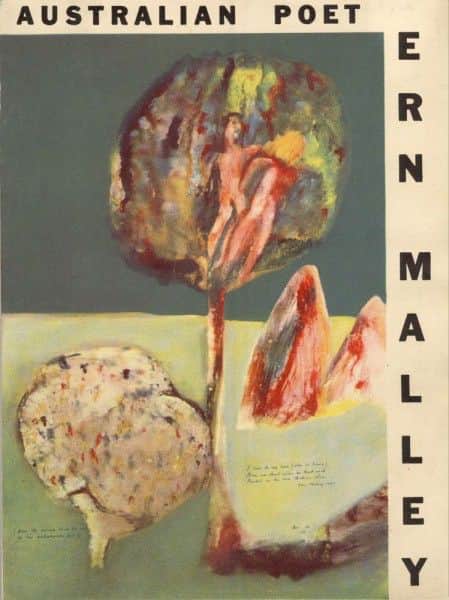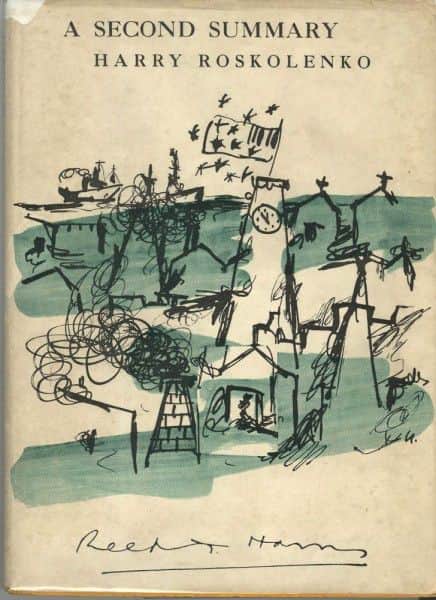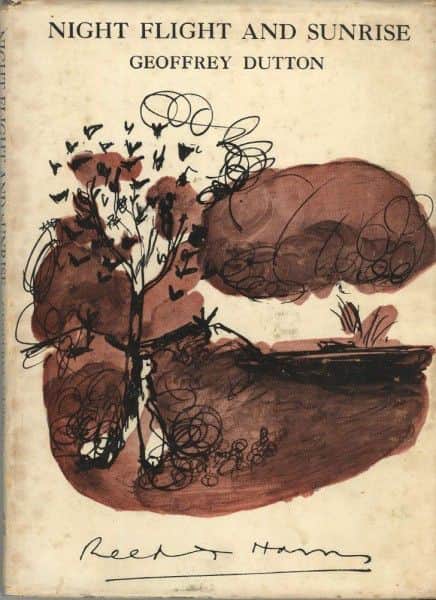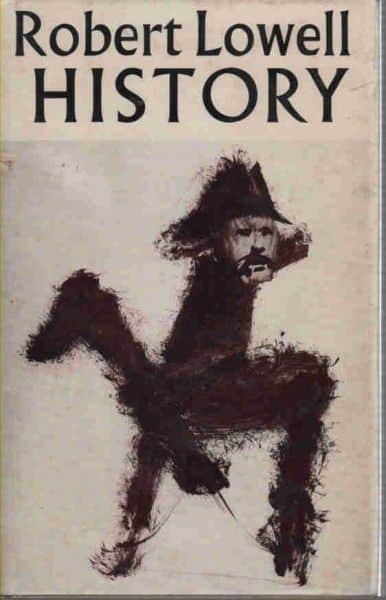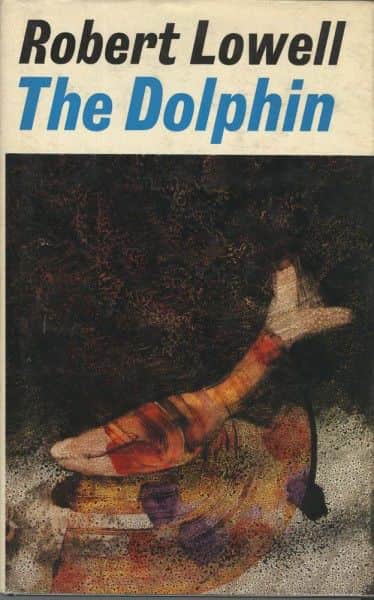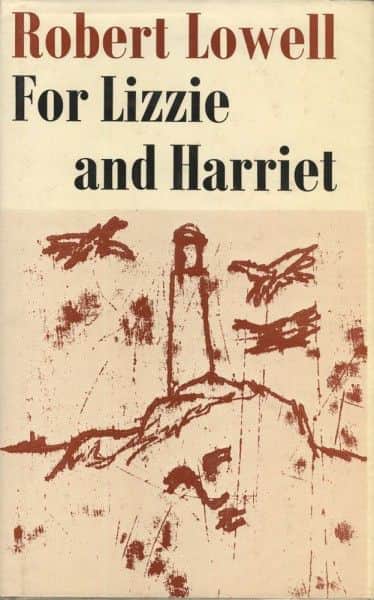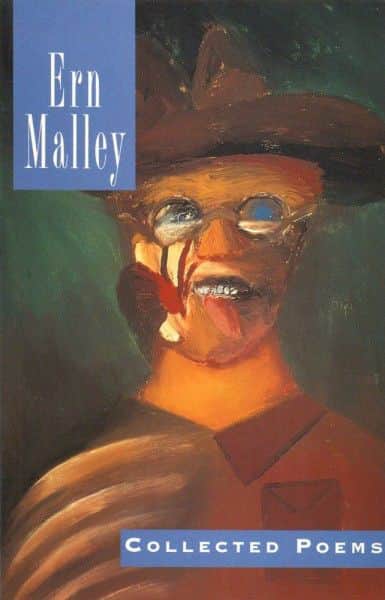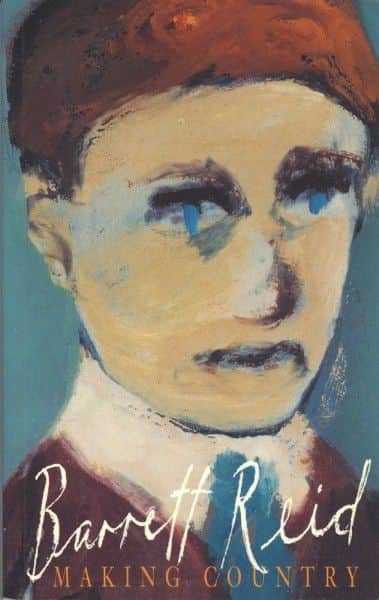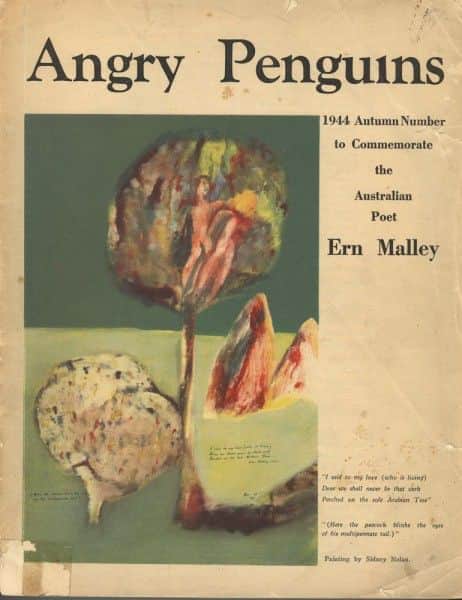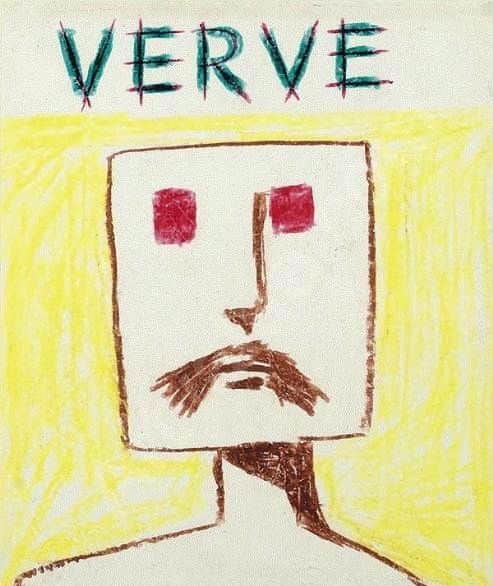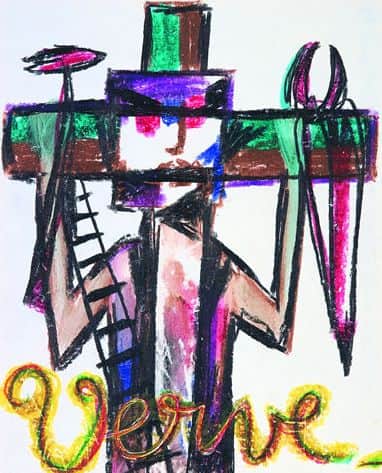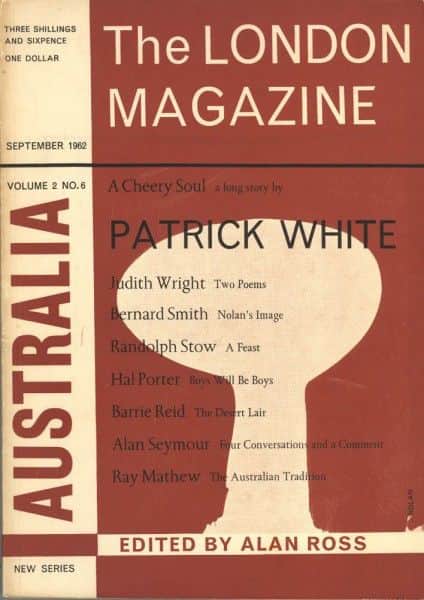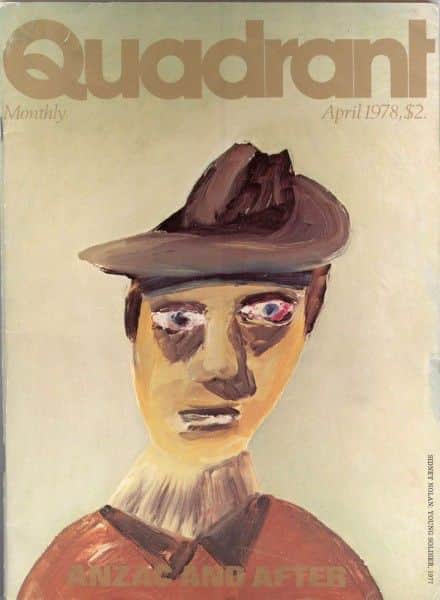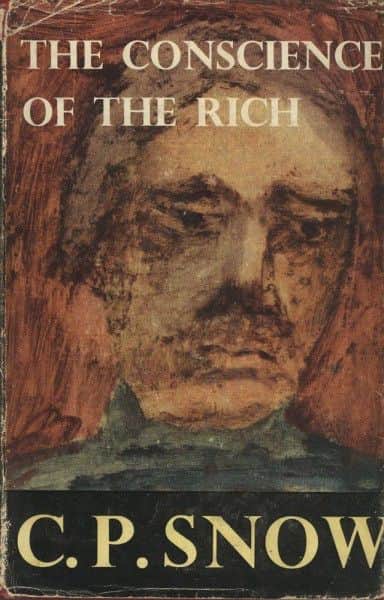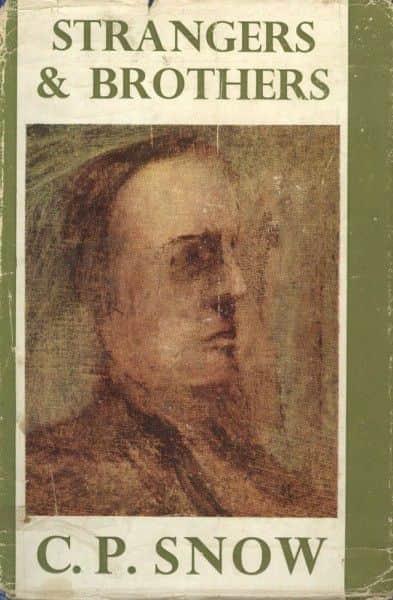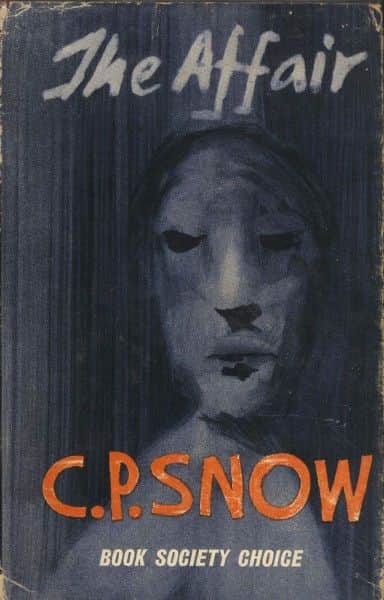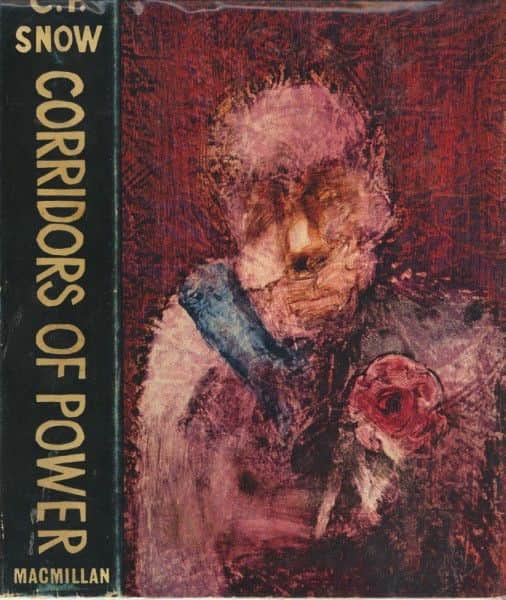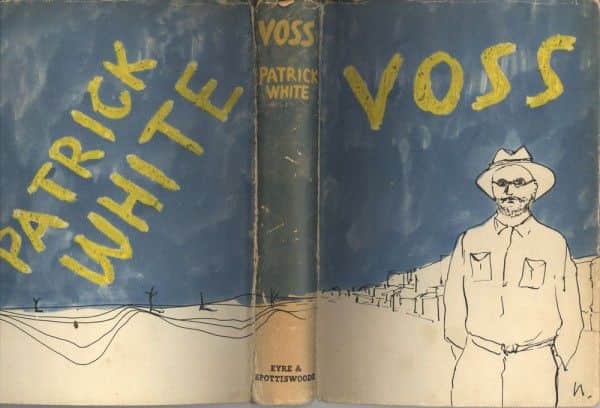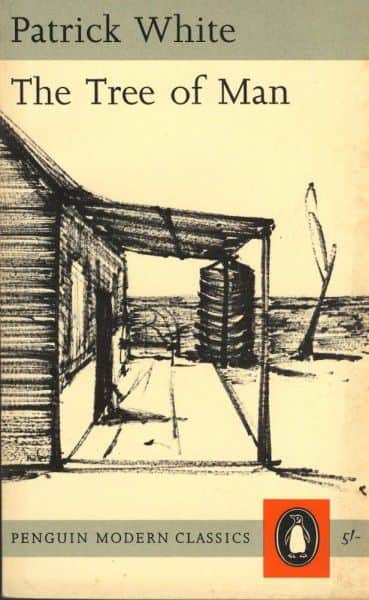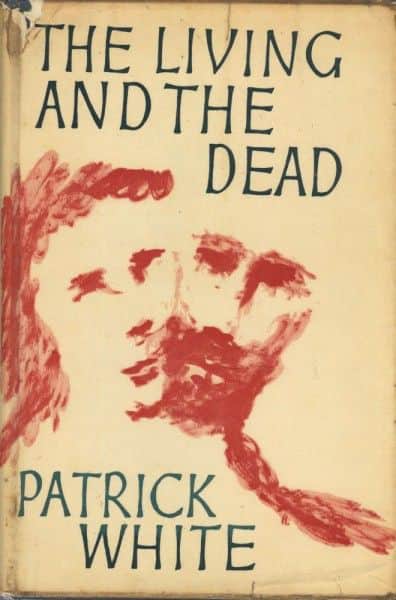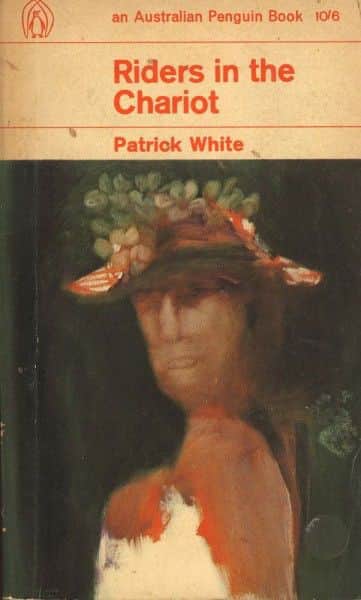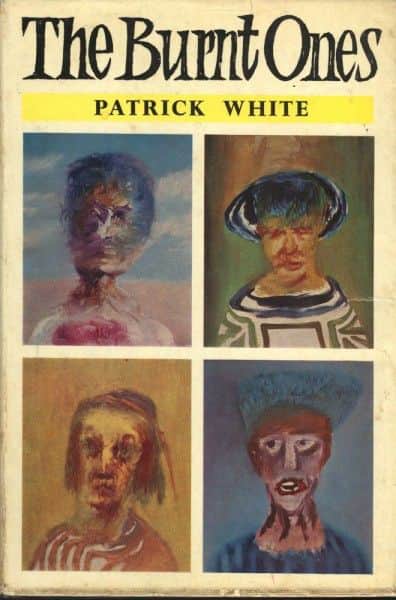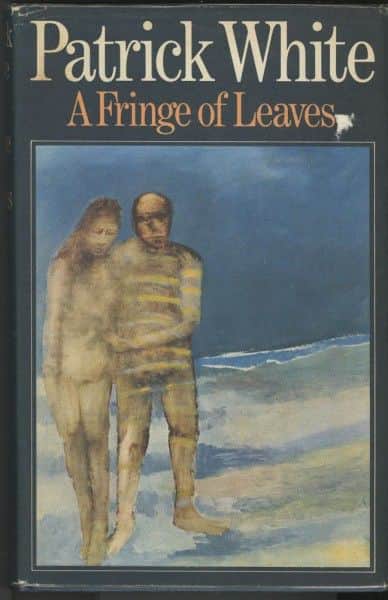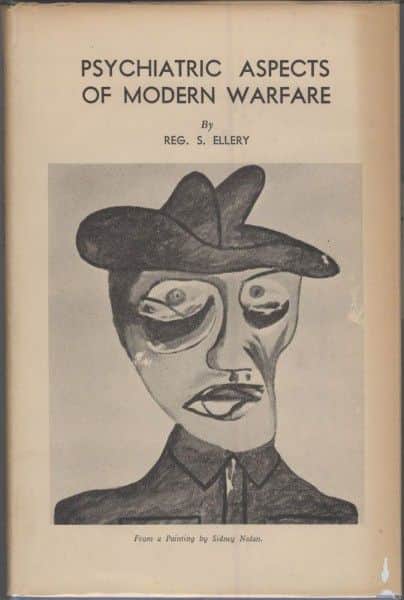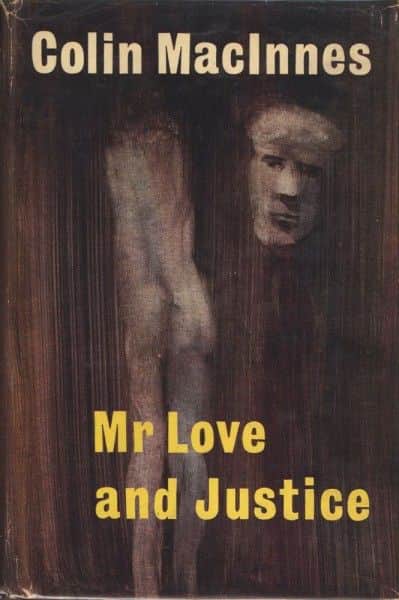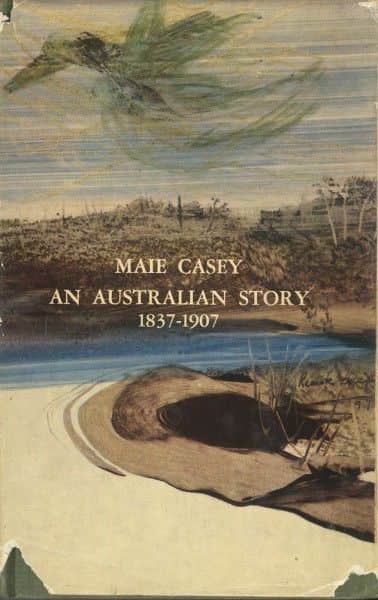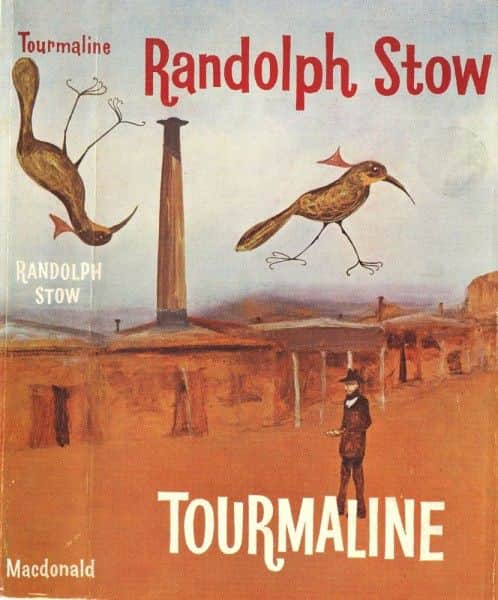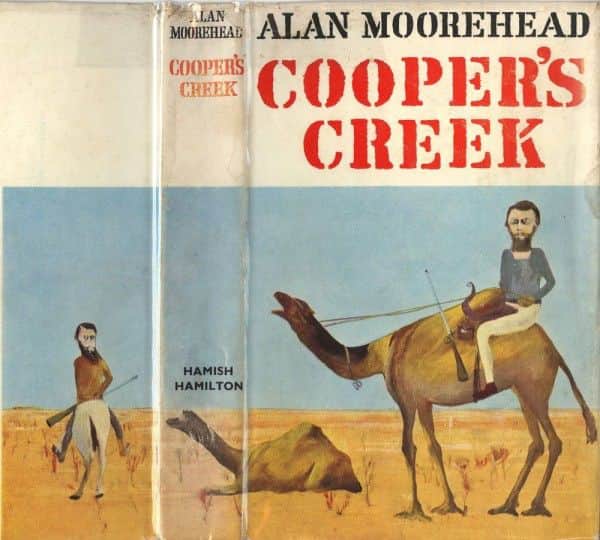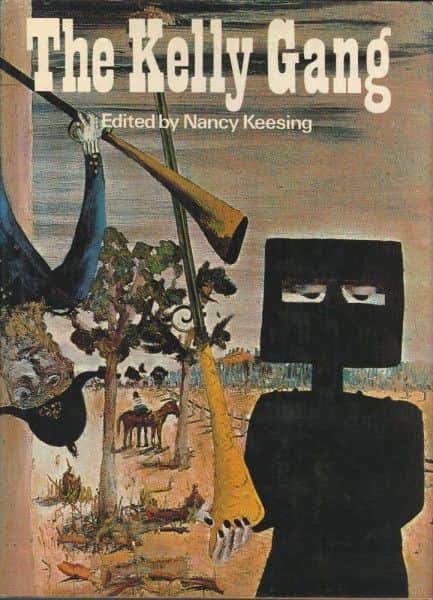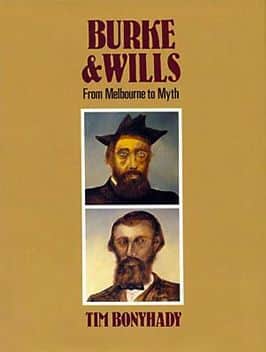Abstract: During his lifetime, Sidney Nolan prepared artwork used on the covers of at least 80 books – this large number reflecting the importance of literature for Nolan. This piece does not examine the influence of literature on Nolan’s life and work in any detail, but rather gathers together in one location, illustrations of the many books for which Nolan either designed covers or which were designed using his works, commencing with his first cover in 1943 for Max Harris’ novella The Vegatative Eye. Images of all covers are gathered under various category headings, followed by a chronological listing of titles.
Introduction Few Australian soldiers in the Second World War travelled with eight volumes of Kierkegaard in their kitbag,1 and few 1930s art students at the National Gallery School in Melbourne spent more time reading literature in the Public Library Reading Room next door than attending art classes. Sidney Nolan qualifies for both improbabilities. The influence of literature on Nolan cannot be underestimated, and while some old masters and modern painters may have influenced Nolan considerably, none became heroes for him as did Rimbaud – ‘The Rimbaud thing almost annihilated me, it was the first time one envisaged not being a cog in a machine’2 – or provided sustenance as did Kierkegaard – ‘I went mad on Kierkegaard for five years. I think in the Army Kierkegaard sustained me’.3 The sister arts of poetry and painting would battle in Nolan throughout his life, even given that of poetry he wrote, “I am reticent about poems, they are too often footnotes to secrets,’4 and of painting he could say with some frankness: ‘Painting is I suppose meant to be a way of getting rid of lies.’5
His gravestone is boldly marked SIDNEY NOLAN PAINTER and unambiguously indicates which of the arts prevailed, but Nolan as poet was no mere sometime thing. He not only read poetry with an insatiable appetite, he wrote poetry and he painted poetry.
On more than one occasion it seems he pondered which call he would answer. ‘The cast iron logic of paint’6 would prevail – as foreshadowed in a letter to the Reeds after he left Heide wherein he stated ‘Painting has become a fairly quite thing for me now. Apparently my life is to be bound up with it for good and all and once you know this it brings a quietitude which can wait its time.’7 But poetry underpinned all his painting; ‘In every case though, the urgent, physical need to work was essentially poetic in its origins, reminding us that, lying behind the apparently casual façade so many of these works seems to present to the world, there is an intense emotionalism, one which, on closer inspection, stops us in our tracks.’8 Ut pictura poesis.9
In this piece however it is not intended to examine the influence of literature on Nolan’s life and work. For those seeking such an exposition, the chapter ‘Nolan and Literature’ in Rosenthal’s monograph10 examines this is some detail. Rather it is intended here to do little more than gather together in one location, illustrations of the many books for which Nolan either designed covers, or which were designed using his works. The gathering does not include Nolan covers on material originating from within the Arts community per se such as exhibition catalogues, gallery catalogues, auction house catalogues, monographs or examinations of the Kelly paintings such as those by Robert Melville in 196411 and Andrew Sayers in 2002.12 Many of the books listed have also been illustrated by Nolan, however the gathering does not include two books he illustrated but which do not have his cover design or illustration.13 One of these, The Children’s Crusade, contains works which – along with those in Paradise Garden and The Darkening Ecliptic – are probably his most significant book illustrations. The covers commence in 1943 with what can be seen as a Wimmera landscape rotated to form a portrait for Max Harris’ novel The Vegetative Eye.14 They total more than 80 and there may well be more – I thought the list complete when in the 50s. Please advise if you know of any omissions.15

Max Harris, “The Vegetative Eye”, Reed & Harris, Melbourne, 1943.
Images of all covers are gathered under various category headings. This is followed by a chronological listing of titles with links to images.
Covers for books of Poetry
Sidney Nolan first designed covers for books of verse in 1944 – the Reed & Harris publications of poets Ern Malley, Harry Roskolenko and Geoffrey Dutton. A cover for a second Roskolenko book followed in 1948, and then nothing until his collaboration with Randolph Stow in 1962. A cover for a Yeats centenary book appeared in 1965, and his close association with Robert Lowell saw covers for several books between 1967 and 1973. Then in 1974 he did two covers for the Ern Malley hoax poems, an image from his New Guinea series was used for a book of preliterate poetry in 1978, and a book of Charles Osborne’s poems appeared in 1984 with a Nolan cover. Two more Ern Malley covers appeared in 1988 and 1993 and finally, three years after Nolan’s death in 1992, his 1946 portrait of Barrett Reid – with whom he travelled through Queensland after he parted company with Heide – was the cover for the Reid anthology Making Country.
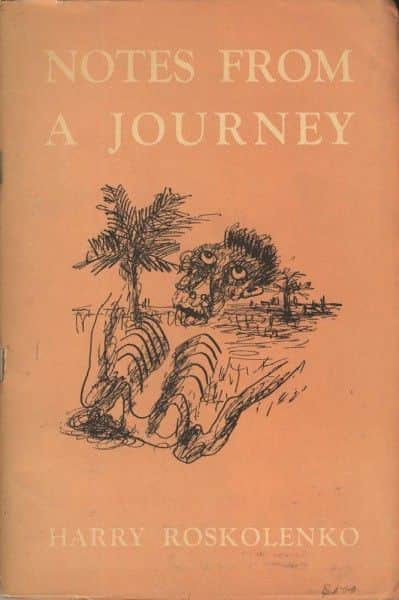
Harry Roskolenko, “Notes from a Journey”, Meanjin Press, Melbourne, 1948.
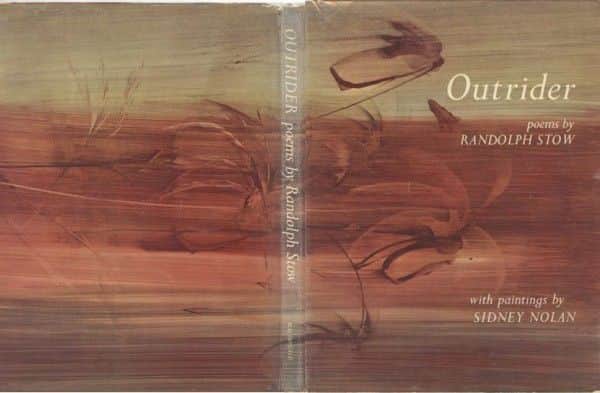
Randolph Stow, “Outrider”, Macdonald, London, 1962.
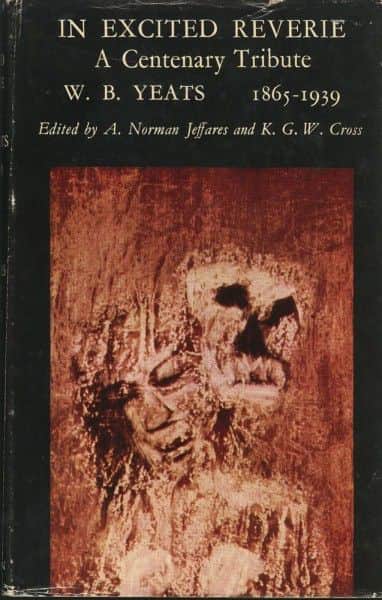
ed. A. Norman Jeffares and K.G.W. Cross, “In Excited Reverie: A Centenary Tribute, W.B. Yeats 1865-1939”, Macmillan, London, 1965.

Robert Lowell, “Near the Ocean”, Farrar, Strauss and Giroux, New York, 1967.
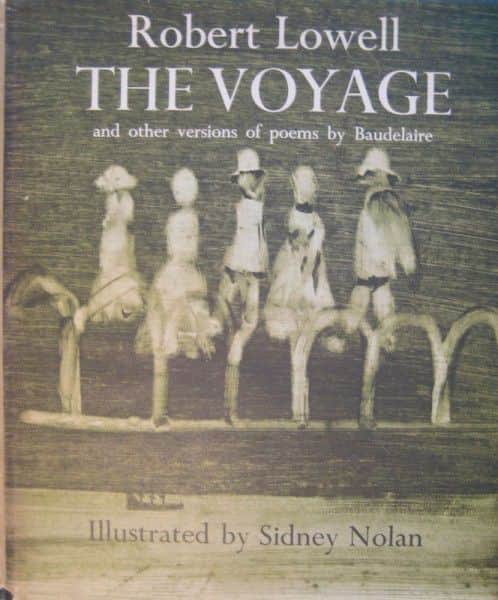
Robert Lowell, “The Voyage and other versions of poems by Baudelaire”, Farrar, Strauss and Giroux, New York, 1968.
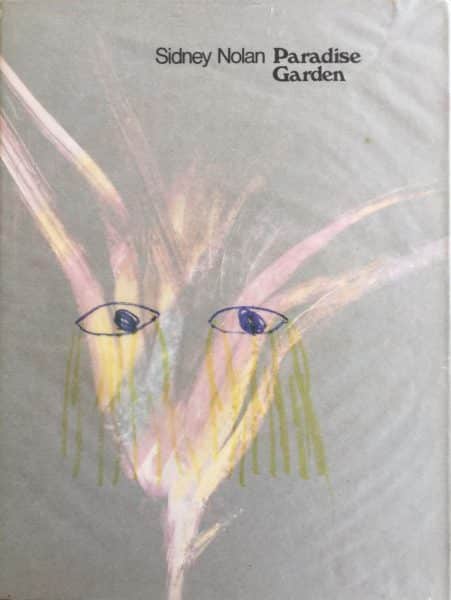
Sidney Nolan, “Paradise Garden”, R. Alistair McAlpine Publishing, London, 1971
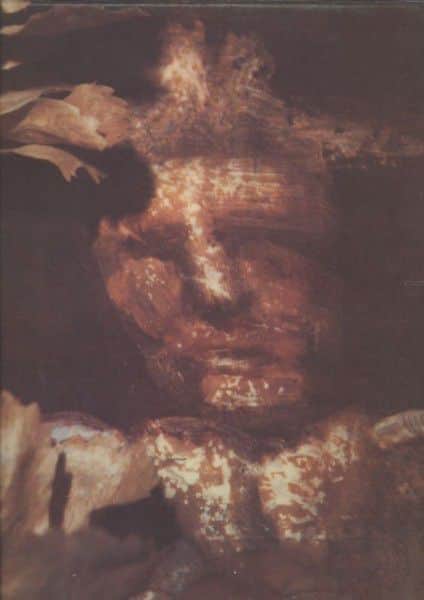
Ern Malley, “The darkening Ecliptic”, R. Alistair McAlpine Publishing, London, 1974.
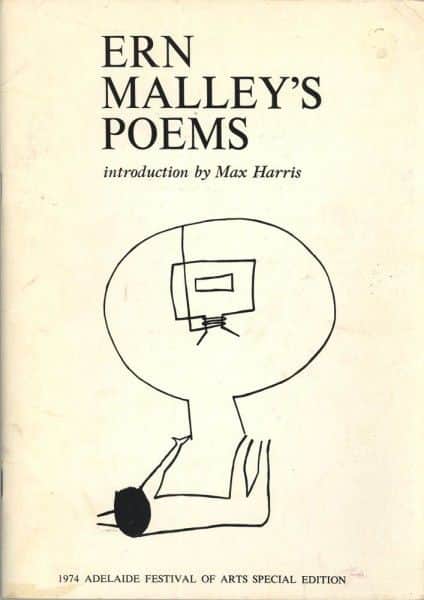
Sidney Nolan, cover for “Ern Malley’s Poems”, Mary Martin Publications, Adelaide, 1974.
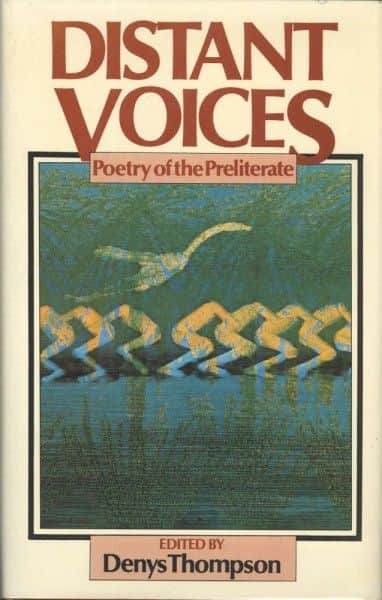
ed. Denys Thompson, “Distant Voices: Poetry of the Preliterate”, Heinemann, London, 1978.
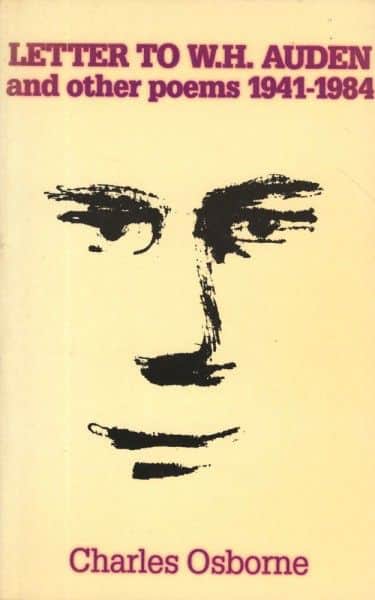
Charles Osborne, “Letter to W.H. Auden and other poems 1941-1984”, John Calder, London, 1984.
Covers for Magazines
Nolan’s first magazine cover was in 1944 for Issue 6 of the Reed & Harris avant garde little magazine Angry Penguins – the issue containing the hoax poems of Ern Malley. Thirty four years later in 1978, the same year he gave more than 250 Gallipoli-themed works to the Australian War Memorial in memory of his younger brother Raymond who had accidentally drowned just 2 weeks before VP Day in 1945, his Young Soldier was the cover for an Anzac issue of Quadrant magazine. Between these two extremes he produced several cover images: a Moonboy morphed to a mushroom cloud for the 1962 cover of an Australian issue of The London Magazine; the December 1962 issue of the poet-painter series of Australian Letters in which he paired with Randolph Stow; and two portraits for Time magazine – Rudolf Nureyev in 1965 and Robert Lowell in 1967. In the mid-1950s, soon after he settled in London, he also prepared several covers for the prestigious French avant-garde magazine Verve – some Kelly themed, some Italian crucifix themed – but none of these, for whatever reason, appeared on the magazine.
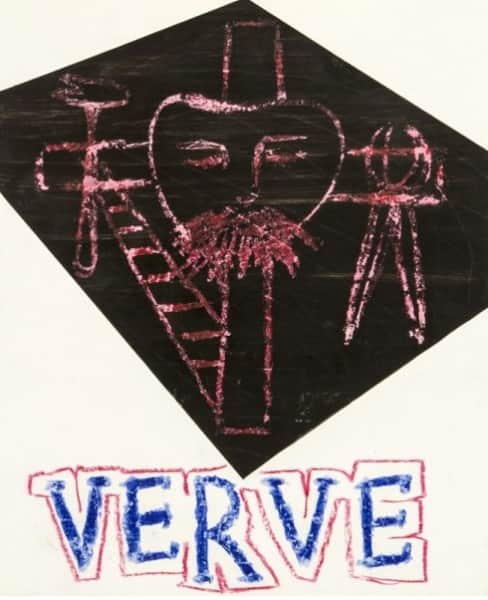
Sidney Nolan, cover design for “Verve”, 1956
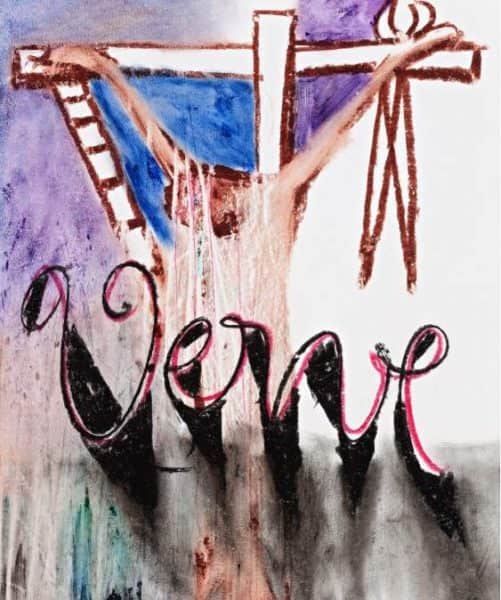
Sidney Nolan, cover design for “Verve”, 1956
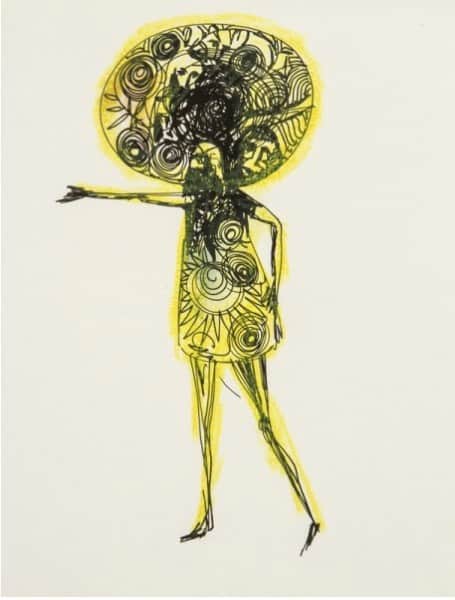
Sidney Nolan, cover design for “Verve”, 1956

Sidney Nolan, cover design for “Verve”, 1956
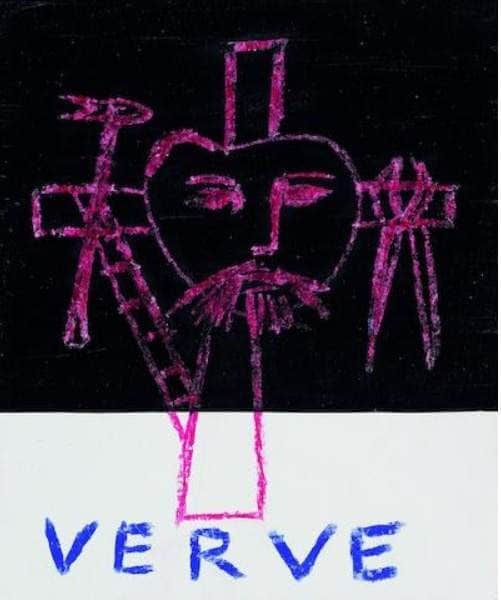
Sidney Nolan, cover design for “Verve”, 1956
Covers for novels by C.P. Snow
By the mid 1950s Nolan had settled permanently in London. With champions like Kenneth Clark, his career was on the move – he had solo exhibitions at Redfern and Whitechapel galleries in London and with Durlacher in New York. What was more, he projected as not quite the archetypal Australian – larriken yes, but learned too; all at a time when so many things Australian were being noticed and were becoming fashionable in the “mother” country.16 C.P. (Sir Charles, later Lord) Snow was a prominent scientist and novelist during this period whose articles, Rede lecture, and book on The Two Cultures – the divide as he saw it between science and the humanities – excited much passion and debate in the late 1950s. He and his wife, the novelist Pamela Hansford Johnson, bought Nolan’s 1954-5 re-creation of the first iconic Kelly from Redfern Galleries – she writing of it ‘It’s a myth sitting there on horseback.’17 The purchase led to Snow and Nolan becoming friends and Snow’s insistance that his books, including the novels in the Strangers and Brothers series, have jackets with paintings by Nolan. All are heads, culminating in a fittingly powerful image for Corridors of Power – at once simian, primal, and yet with the innate vulnerability of ageing leaders of the pack – the book whose title has become the sobriquet for the world Snow portrays, indeed in which he lived.

C.P. Snow, Macmillan, London, reprints, from left to right: “The New Men’, 1960; “The Masters”, 1959; “The Conscience of the Rich”, 1960.

C.P. Snow, Macmillan, London, reprints, from left to right: “Time of Hope’, 1961; “The Light and the Dark”, 1958; “Homecomings”, 1961.
Covers for novels by Patrick White
Nolan did covers for several novels by Patrick White beginning with Voss in 1957 and ending with A Fringe of Leaves in 1976. The covers can be seen as charting their twenty year friendship which began in 1958 when Nolan, travelling through America on a Harkness Fellowship with his wife Cynthia and step-daughter Jinx, met White in Fort Lauderdale, Florida.18 Nolan had already designed the Voss cover at White’s request, and after their meeting White wrote to a friend: ‘Sidney N. seems to be completely honest and without nonsense … I can’t think when I have met a man so much himself …’19 White developed a particularly close and special rapport with Cynthia Nolan and he was devastated to learn of her suicide not long after A Fringe of Leaves was published,. He was angered 15 months later when Nolan married Arthur Boyd’s sister Mary, the former wife of John Perceval. Neither his anger nor his reassessment of Nolan’s capabilities were hidden when his autobiography Flaws in the Glass 20 appeared in 1981 – a title quickly spoonerised to Claws in the Arse. Both good haters, they were heading for the OK Corral and Nolan’s response was swift. He painted Nightmare, a diptych in which a flea-like creature with the face of White’s partner Manoly Lascaris backs up towards a White-like figure, and exhibited it at the Perth Festival in 1982. Their friendship had reached its dramatic and very public conclusion, and in the aftermath White ensured Nolan’s works no longer graced his covers.21
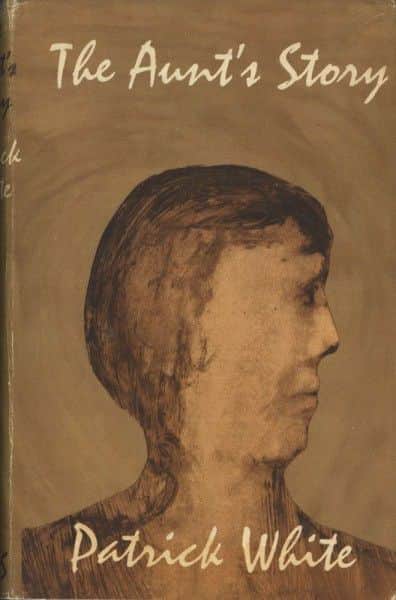
Patrick White, “The Aunt’s Story”, Eyre &Spottiswoode, London, 1958.

Patrick White, “Voss”, Penguin, Mitcham Vic., 1960.
Covers for novels by Cynthia Nolan
The third author for whom Nolan produced several covers was his wife Cynthia. Married for almost 30 years, the Nolans’ life together can be summarised as travel, painting, success, fame, and some unhappiness for him; travel, writing, less fame, greater unhappiness and eventual suicide for her. Nolan’s career is well known: famed and feted, he became a knight of the realm, recipient of honorary doctorates, and was given huge international retrospective exhibitions. Cynthia’s career is less known, other than as the travel-book-writing wife of the famous painter.22
As with his friendship with White, Nolan’s book covers for Cynthia can be seen as charting the milestones (literally – they describe their travellings together) of their marriage. Outback – his first cover for her – describes their journeys to the Outback and Central Australia in the early years of their marriage; the last, Paradise and yet, tells of their visit to New Guinea. In between, they travel across America, Africa and China in a hagiographic halo centered on Sidney. Her last book Paradise and yet coincides with his Paradise Garden.23 Are the namings coincidental, or telling? His paradise – perhaps a Heide hell of sorts; her paradise – perhaps reflected in Nolan’s thought on tropical islands as she quotes him on her last published page: ‘They’re Paradise. And yet – the bough is faithful to the serpent’s flower.’
In 1994, two years after Nolan’s death and long after Cynthia’s in 1975, illustrated abridgements of Paradise and yet, One traveller’s Africa, Outback and A sight of China were published under the title Outback and beyond: the travels of Cynthia and Sidney Nolan. Nolan’s 1948 painting Pretty Polly Mine adorns the cover.

Cynthia Nolan, “A Sight of China”, Macmillan, London, 1969.
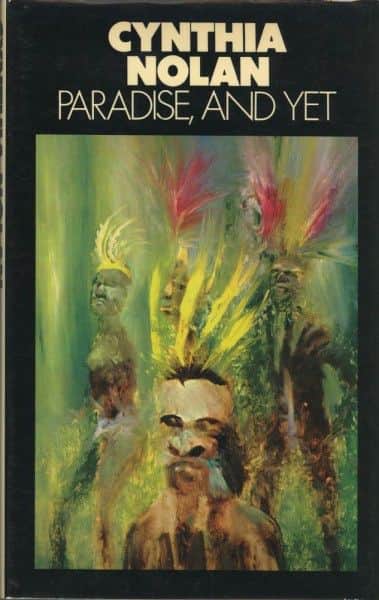
Cynthia Nolan, “Paradise, and yet”, Macmillan, London, 1971.

Cynthia Nolan, “Outback and beyond: the travels of Cynthia and Sidney Nolan”, Imprint, Angus & Robertson, Sydney, 1994
Covers for other novels and books
The remaining covers by Nolan span almost 40 years from the first in 1943 for The Vegetative Eye by Max Harris with whom Nolan first travelled to Glenrowan and the Kelly Country late in 1945. The range of authors and of subject matter provide a snapshot of Nolan’s interests and contacts: Max Harris, Reg Ellery, Colin MacInnes, Maie Casey, Randolph Stow, Alan Moorehead, George Johnston, Charles Osborne, Michael Alexander, Samuel Beckett; covering psychiatry, history, war, theatre, novels, biography, current affairs. Nolan died in 1992, the same year his painting of Simpson and the Donkey was used on a book examining this famous Gallipoli legend. One of his last interviews was with Michael Heyward who was researching the Ern Malley poetry hoax perpetrated on the editors of Angry Penguins (including Nolan and Harris), and the cover for Heyward’s book The Ern Malley Affair carries Nolan’s ghostly ghoulish portrait of the non-existent Malley. Then eight years after his death, the first of Nolan’s original Kelly series was used for the cover of Peter Carey’s novel The True History of the Kelly Gang, and the following year a later Kelly painting appeared on the cover of The Jerilderie Letter.

Max Harris, “The Vegetative Eye”, Reed & Harris, Melbourne, 1943.
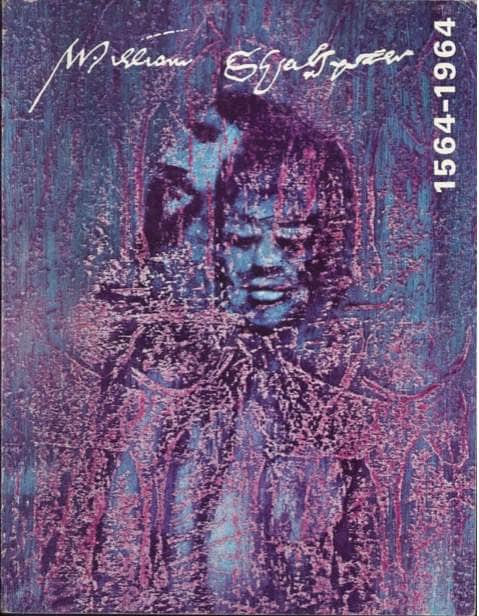
“The Shakespeare Exhibition 1564 – 1964”, Arts Council of Great Britain, London, 1964
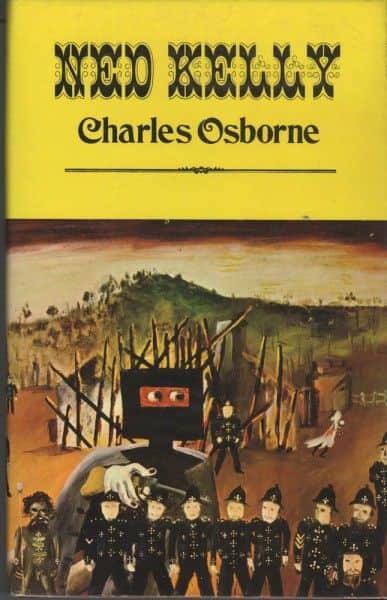
Charles Osborne, “Ned Kelly”, Anthony Blond, London, 1970.

Michael Alexander, “Mrs Fraser On The Fatal Shore”, Michael Joseph, London, 1971.

Samuel Beckett, “Waiting for Godot”, Faber & Faber, London, 1965.
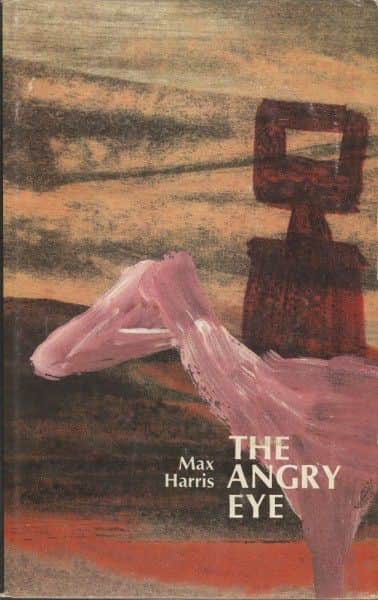
Max Harris, “The Angry Eye”, Pergamon, Sydney, 1973.
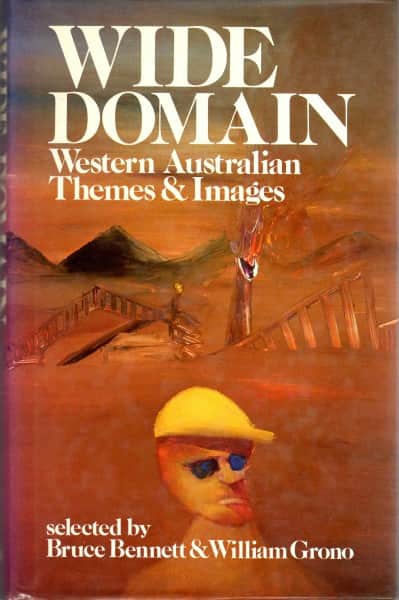
ed. Bruce Bennett & William Grono, “Wide Domain: Western Australian Themes and Images”, Angus and Robertson, Sydney, 1979
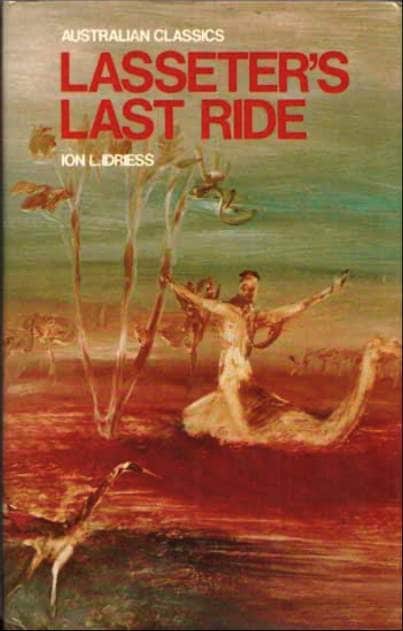
Ion L Idriess, “Lasseter’s Last Ride”, Angus & Robertson, Sydney, 1980

Max Brown, “Ned Kelly: Australian son”, Angus & Robertson, Sydney, 1980
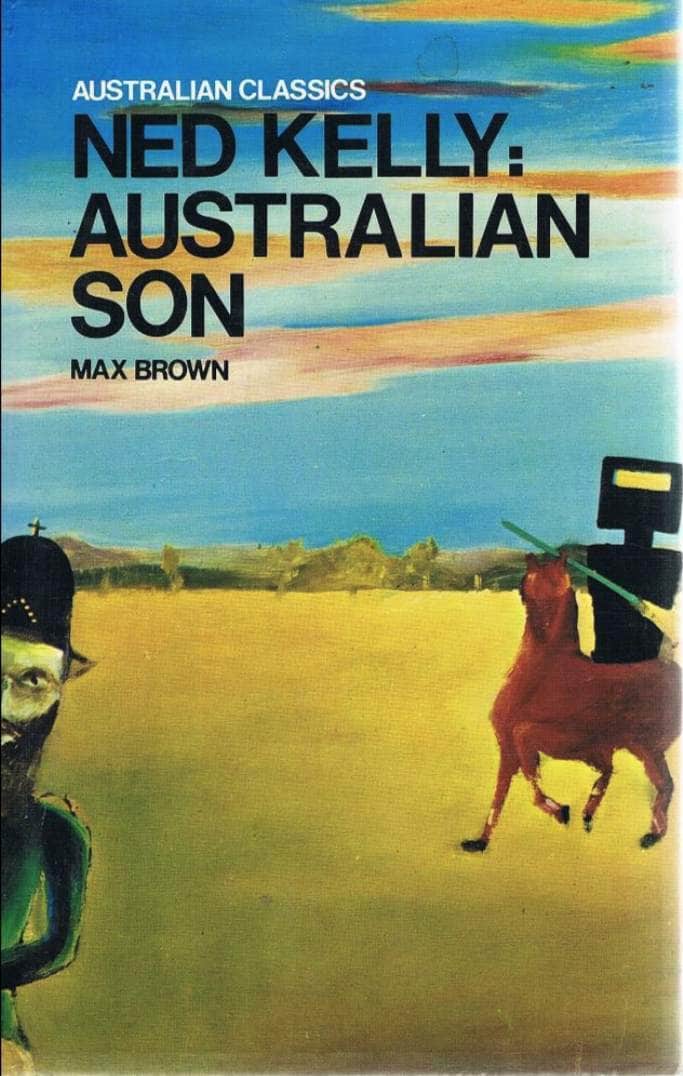
Max Brown, “Ned Kelly: Australian son”, Angus & Robertson, London, 1980
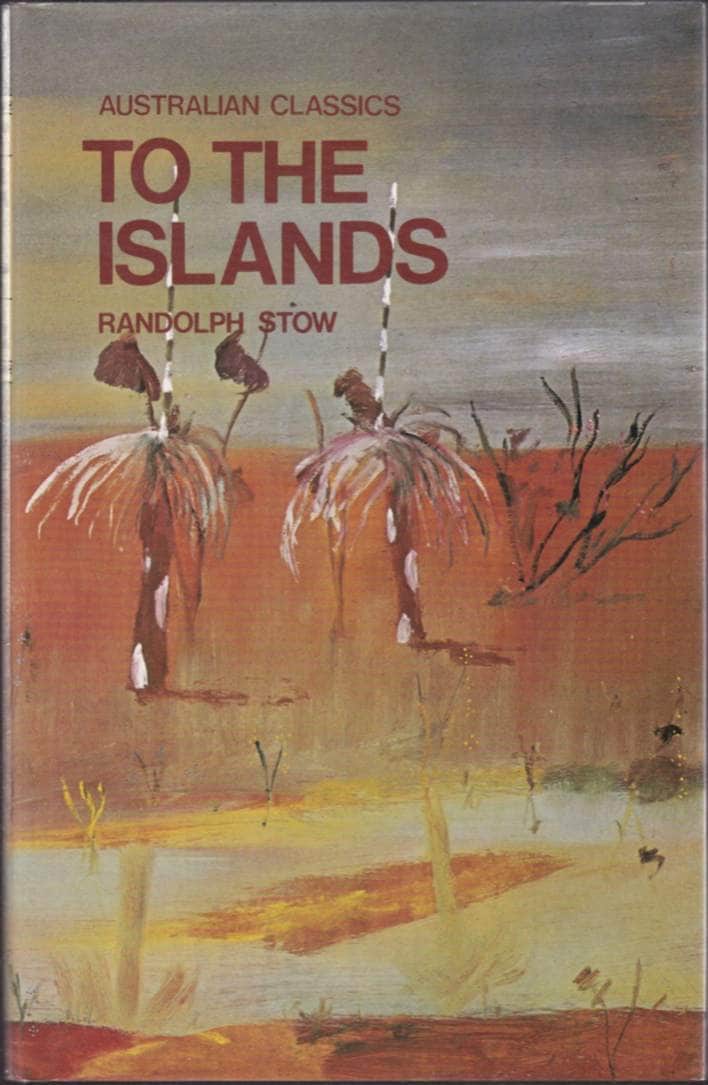
Randolph Stow, “To the Islands”, Angus & Robertson, Sydney, 1981

Max Brown, “Ned Kelly: Australian son”, Angus & Robertson, Sydney, 1981
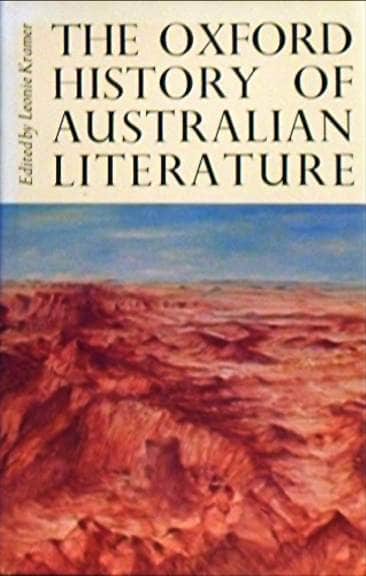
ed Leonie Kramer, “The Oxford History of Australian Literature”, Oxford University Press, Oxford, 1981

Mrs Aeneas Gunn, “We of the Never-Never”, Angus & Robertson, Sydney, 1982
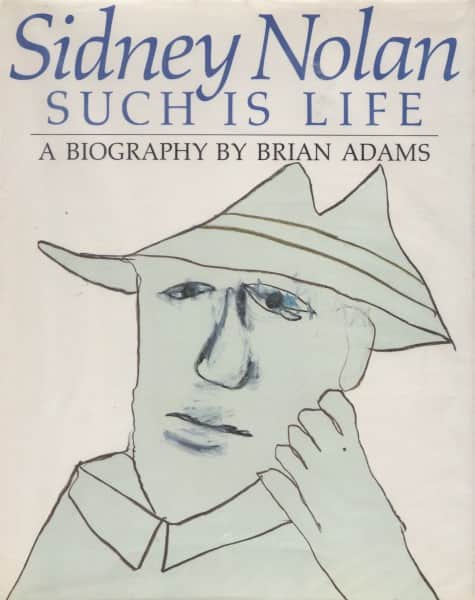
Brian Adams, “Sidney Nolan: Such is Life, a biography”, Century Hutchinson, Melbourne, 1987
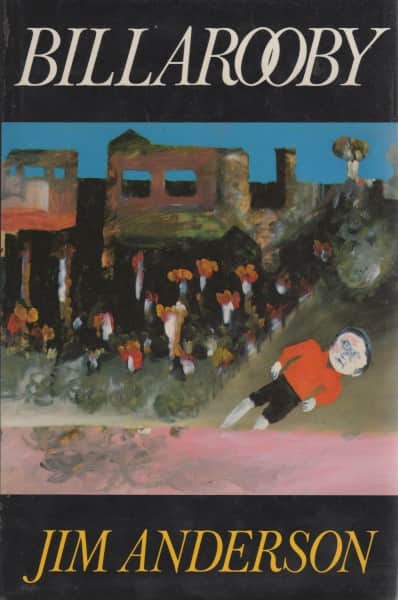
Jim Anderson, “Billarooby”, Grafton Books, London, 1989
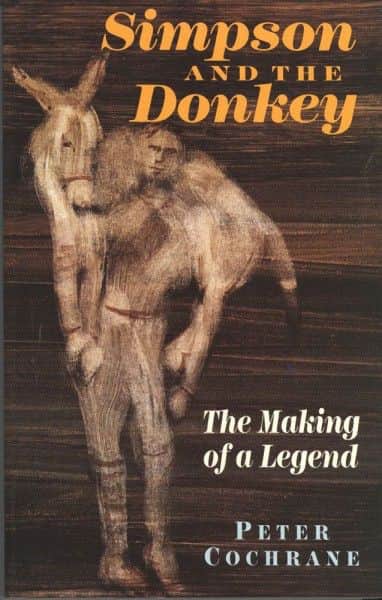
Peter Cochrane, “Simpson and the Donkey: The Making of a Legend”, Melbourne University press, Carlton Vic., 1992

ed. Alex McDermott, “The Jerilderie Letter”, Faber and Faber, London, 2001.
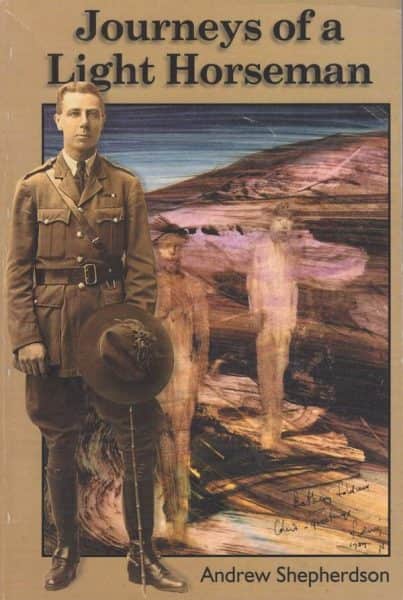
Andrew Shepherdson, “Journeys of a Light Horseman”, A. Shepherdson, Newtown, Tasmania, 2002

Tim Bonyhady, “Burke & Wills : from Melbourne to myth”, National Library of Australia, Canberra, 2002
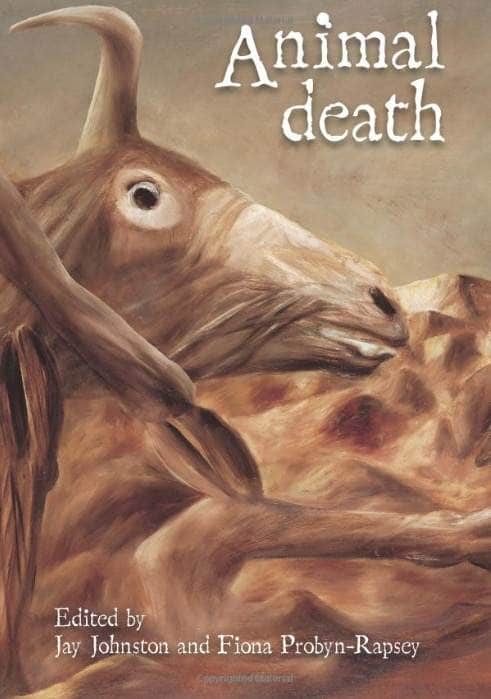
ed. Jay Johnston and Fiona Probyn-Rapsey, “Animal Death”, Sydney University Press, Sydney, 2013

Nancy Underhill, “Sidney Nolan: a life”, NewSouth Publishing, Sydney, 2015
Cover for an LP record
One Nolan cover remains – his only cover for a record. The Art Gallery of South Australia mounted a monumental exhibition of Nolan’s Ern Malley and Paradise Garden paintings in 1974 for the Adelaide Festival. With Nolan in attendance, the exhibition was opened by Australian Prime Minister Gough Whitlam,24 while in the foyer Dave Dallwitz25 and his Jazz Band played Dallwitz’s Ern Malley Jazz Suite. The LP was released the next year, covered with Nolan’s portrait of Malley.

Dave Dallwitz, “Ern Malley Jazz Suite”, Swaggie Records, Melbourne, 1975.
Chronological listing
1943
Max Harris, The Vegetative Eye, Reed & Harris, Melbourne
1944
Angry Penguins, No 6 Autumn Number, Reed & Harris, Melbourne
Harry Roskolenko, A Second Summary, Reed & Harris, Melbourne
Geoffrey Dutton, Night Flight and Sunrise, Reed & Harris, Melbourne
Ern Malley, The Darkening Ecliptic, Reed & Harris, Melbourne
1945
Reg. S. Ellery, Psychiatric Aspects of Modern Warfare, Reed & Harris, Melbourne
1948
Harry Roskolenko, Notes from a Journey, Meanjin Press, Melbourne
1956
Cover design for Verve (1)
Cover design for Verve (2)
Cover design for Verve (3)
Cover design for Verve (4)
Cover design for Verve (5)
Cover design for Verve (6)
Cover design for Verve (7)
1957
Patrick White, Voss, Eyre & Spottiswoode, London
1958
Patrick White, The Aunt’s Story, Eyre &Spottiswoode, London
C.P. Snow, The Conscience of the Rich, Macmillan, London
C.P. Snow, Strangers & Brothers, Macmillan, London
C.P. Snow, The Light and the Dark, Macmillan, London
1959
C.P. Snow, The Masters, Macmillan, London
1960
C.P. Snow, The Affair, Macmillan, London
C.P. Snow, The New Men, Macmillan, London
C.P. Snow, The Conscience of the Rich, Macmillan, London
Patrick White, Voss, Penguin, Mitcham Vic.
Colin MacInnes, Mr Love and Justice, MacGibbon & Kee, London
1961
C.P. Snow, Time of Hope, Macmillan, London
C.P. Snow, Homecomings, Macmillan, London
Patrick White, The Tree of Man, Penguin, Mitcham Vic.
Patrick White, Riders in the Chariot, Eyre & Spottiswoode, London
1962
Randolph Stow, Outrider, Macdonald, London
The London Magazine, Vol. 2 No. 6, London
Australian Letters: A Quarterly Review of Writing and Criticism, Vol. 5, No. 2
Patrick White, The Living and the Dead, Eyre & Spottiswoode, London
Cynthia Nolan, Outback, Methuen, London
Maie Casey, An Australian Story 1837-1907, Michael Joseph, London
1963
Patrick White, The Aunt’s Story, Penguin, Mitcham Vic.
Alan Moorehead, Cooper’s Creek, Hamish Hamilton, London
Randolph Stow, Tourmaline, Macdonald, London
1964
C.P. Snow, Corridors of Power, Macmillan, London
Patrick White, The Burnt Ones, Eyre & Spottiswoode, London
George Johnston, My Brother Jack, Collins, London
Patrick White, Riders in the Chariot, Penguin, Ringwood Vic.
William Shakespeare 1564-1964, The Shakespeare Exhibition, London, 1964.
1965
ed. A. Norman Jeffares and K.G.W. Cross, In Excited Reverie: A Centenary Tribute, W.B. Yeats 1865-1939, Macmillan, London
Time, Vol. 87, No. 16, New York
Cynthia Nolan, One Traveller’s Africa, Methuen, London
1967
Robert Lowell, Near the Ocean, Farrar, Strauss and Giroux, New York
Time, Vol. 89 No. 22, New York
Cynthia Nolan, Open Negative: An American Memoir, Macmillan, London
Cover design (unpublished) for Voss
1968
Robert Lowell, The Voyage and other versions of poems by Baudelaire, Farrar, Strauss and Giroux, New York
1969
Cynthia Nolan, A Sight of China, Macmillan, London
1970
Charles Osborne, Ned Kelly, Anthony Blond, London
1971
Sidney Nolan, Paradise Garden, R. Alistair McAlpine Publishing, London
Cynthia Nolan, Paradise, and yet, Macmillan, London
Michael Alexander, Mrs Fraser On The Fatal Shore, Michael Joseph, London
1973
Robert Lowell, History, Faber & Faber, London
Robert Lowell, The Dolphin, Faber & Faber, London
Robert Lowell, For Lizzie and Harriet, Faber & Faber, London
Samuel Beckett, Waiting for Godot, Faber & Faber, London. 2nd Ed., 1965, reprinted 1973
Max Harris, The Angry Eye, Pergamon, Sydney
1974
Ern Malley, The Darkening Ecliptic, R. Alistair McAlpine Publishing, London
Ern Malley’s Poems, Mary Martin Publications, Adelaide
1975
ed. Nancy Keesing, The Kelly Gang, Ure Smith, Sydney
Dave Dallwitz, Ern Malley Jazz Suite, Swaggie Records, Melbourne
1976
Patrick White, A Fringe of Leaves, Jonathan Cape, London
1978
ed. Denys Thompson, Distant Voices: Poetry of the Preliterate, Heinemann, London
Quadrant, No. 129 Volume XXII No. 4, Sydney, April, 1978
1979
ed. Bruce Bennett & William Grono, Wide Domain: Western Australian Themes and Images, Angus and Robertson, Sydney, 1979
1980
Ion L Idriess, Lasseter’s Last Ride, Angus & Robertson, Sydney, 1980
Max Brown, Ned Kelly: Australian son, Angus & Robertson, Sydney, 1980
Max Brown, Ned Kelly: Australian son, Angus & Robertson, London, 1980
1981
Randolph Stow, To the Islands, Angus & Robertson, Sydney, 1981 (revised edition, 2nd printing)
Max Brown, Ned Kelly: Australian son, Angus & Robertson, Sydney, 1981
ed Leonie Kramer, The Oxford History of Australian Literature, Oxford University Press, Oxford, 1981
1982
Mrs Aeneas Gunn, We of the Never-Never, Angus & Robertson, Sydney, 1982
1984
Charles Osborne, Letter to W.H. Auden and other poems 1941-1984, John Calder, London
1987
Brian Adams, Sidney Nolan: Such is life, a biography, Century Hutchinson, Melbourne
1988
Ern Malley, The poems, Allen & Unwin, Sydney
1989
Jim Anderson, Billarooby, Grafton Books, London
1991
Tim Bonyhady, Burke & Wills : from Melbourne to myth, David Ell Press, Balmain N.S.W.
1992
Peter Cochrane, Simpson and the Donkey: The Making of a Legend, Melbourne University Press, Carlton Vic.
1993
Michael Heyward, The Ern Malley Affair, University of Queensland Press, Brisbane
Ern Malley, Collected Poems, Angus & Robertson, Sydney
1994
Cynthia Nolan, Outback and beyond: the travels of Cynthia and Sidney Nolan, Imprint, Angus and Robertson, Sydney
1995
Barrett Reid, Making Country, Angus & Robertson, Sydney
2000
Peter Carey, True History of the Kelly Gang, Knopf, New York
2001
ed. Alex McDermott, The Jerilderie Letter, Faber and Faber, London
2002
Tim Bonyhady, Burke & Wills : from Melbourne to myth, National Library of Australia, Canberra
Andrew Shepherdson, Journeys of a Light Horseman, A. Shepherdson, Newtown, Tasmania
2013
ed. Jay Johnston and Fiona Probyn-Rapsey, Animal Death, Sydney University Press, Sydney
2015
Nancy Underhill, Sidney Nolan: A Life, NewSouth Publishing, Sydney
FOOTNOTES
- Sidney Nolan, interview by Bernard Smith, April 1962, quoted in Nancy Underhill, Nolan on Nolan, Viking, Camberwell Vic., p. 245.
- ibid.
- ibid.
- Sidney Nolan, Letter to Sunday Reed, 12 January 1944, quoted in Underhill, Nolan on Nolan, op. cit., p. 132.
- Sidney Nolan, Sydney Nolan and Ern Malley, Beyond is Anything, ABC Time Exposure, TV documentary, 1974, quoted in Underhill, Nolan on Nolan, op. cit., p. 5 and 261.
- Sidney Nolan, letter to John Reed, 8 February 1943, quoted in Andrew Sayers, ‘Kelly’s Words, Rousseau, and Sunlight’ in Warwick Reeder (ed.), The Ned Kelly Paintings: Nolan at Heide 1946-47, The Museum of Modern Art at Heide, 1997, p. 24; and in Kendrah Morgan and Luke Morgan, ‘The Cast Iron Logic of Paint: Ned Kelly’s Modernist Mask’ in Unmasked: Sidney Nolan and Ned Kelly 1950 – 1990, Heide Museum of Modern Art, 2006, p. 49.
- Sidney Nolan, Letters to John Reed, 14 January 1948, Papers of John & Sunday Reed, Australian Manuscripts Collection, State Library of Victoria, MS 13186, Box 2, File 6.
- Nicholas Usherwood, Foreward in Nolan’s Nolans; A reputation Reassessed, Thos. Agnew and Sons, London, 1997, unpaginated.
- One of the first book covers painted by Nolan was for the 6th issue of Angry Penguins magazine which contained the poems of Ern Malley, written by James McAuley and Harold Stewart to hoax the Angry Penguin editors who included Nolan. A World of its Own, McAuley’s last book of poems, was published two years after he died. The very last of these poems is ‘Sister Arts’ in which McAuley says what Nolan’s artistic life evinces: ‘… that both are grounded in the real, / Though in their transformations they are free / And different.’ Click here to see the poem in McAuley’s own handwriting.
- T.G. Rosenthal, Sidney Nolan, Thames & Hudson, London, 2002, p. 221.
- There are two publications: Robert Melville, Ned Kelly: 27 paintings by Sidney Nolan Thames and Hudson, London, 1964; and The legend of Ned Kelly, Australia’s outlaw hero, paintings by Sidney Nolan, text by Robert Melville, introduction by Alan Moorehead, The Viking Press, New York, 1964.
- Sidney Nolan’s Ned Kelly, with essays by Andrew Sayers and Murray Ball, National Gallery of Australia, Canberra, 2002.
- These two books are: Swansong, poems by Charles Osborne, Shenval Press, London, 1968; and The Children’s Crusade, music by Benjamin Britten, words by Bertolt Brecht, Faber & Faber, London, 1973.
- Nolan reviewed the novel in Angry Penguins No. 6 (Reed & Harris, Melbourne, June 1944, p.104) saying ‘Max has realised, what is so important today and so rare as to be almost a phenomenon, the significance which lies beneath legend. … Sailors say that on the sea at night you can only distinguish lights clearly by glancing either to one side or the other. I feel it is somewhat in this manner that my chalk drawing for The Vegetative Eye came to the surface. A painting is generally the result of an underground disturbance; when the disturbance is an almost biblical moving of the bowels one can only trace the convolutions by oblique means. And in the end, as with most things, one backs a hunch’.
- Rosenthal suggests (see Sidney Nolan, op. cit., p. 290) that in 1967 Nolan did illustrations and book-cover for the Lowell prose play Prometheus Bound, but I can find no publication in that year. The Farrar, Straus & Giroux publication in 1969 has no illustrations and the cover is not by Nolan.
- For an in depth account of this period see Simon Pierse, Australian art and artists in London, 1950-1965 : an antipodean summer, Ashgate, Farnham, Surrey, 2012.
- See Rosenthal, Nolan, op. cit., p 243; also his article Nolan and Cambridge, Cambridge Alumni Magazine, No. 32, Michelmas 2002, p. 34-35.
- A more detailed account of their friendship and its spectacular ending appears in the essay Threads.
- Patrick White letter to David Moore 15 September 1958. See David Marr, Patrick White Letters, Random House, 1994, p. 148.
- Patrick White, Flaws in the Glass, Jonathan Cape, London, 1981.
- White selected New York artist Mel Odom to replace Nolan on Voss and A Fringe of Leaves.
- Jane Grant, The Life and Work of Cynthia Reed Nolan, PhD Thesis, University of Sydney, March 2002. This thesis gives a comprehensive account of her life.
- Nolan wrote the vitriolic, highly personal poems Paradise Garden about his failed relationship with Cynthia’s brother and sister-in-law John and Sunday Reed at Heide during the 1940s. The poems were published in a spectacular book he lavishly illustrated. (Sidney Nolan, Paradise Garden, McAlpine, London, 1971.) With his American film director friend Stuart Cooper (who still owns the film rights to Voss) he made the film Paradise Garden with narration and recitation of the poems by Orson Welles. (Festival Exhibitions 1974, The Art Gallery of South Australia, Adelaide, 1974, p. 21).
- The year following the Adelaide exhibition Whitlam was dismissed from office and the Dismissal, as it became known, was one of a number of themes Nolan had in mind to paint. He told Michael Heyward in 1991: ‘Whitlam wants me to paint the whole thing of the Dismissal, because I know most of the people …. Whitlam says, said, to me “Why don’t you paint it” and I said “OK I will – when you come clean” …. because he won’t quite come clean and I can guess why too, ‘cause once again it’s the CIA involvement … which he denies, but nothing’s very clear and that’s the way it went.’ (Sidney Nolan, interview with Michael Heyward, 5 April 1991, Heyward Papers, Australian Munuscripts Collection, State Library of Victoria, Melbourne, MS13673, box 5).
- An Adelaide painter and musician, Dallwitz had a longer acquaintance with Malley than most. In November 1943, he and his wife-to-be Jean were at an undergrad haunt in Rundle Street, when a breathless Max Harris burst in with the first Malley poems he had just received from Ern’s sister Ethel. (John Dallwitz, son of Dave and Jean, phone conversation with writer, 2007).


